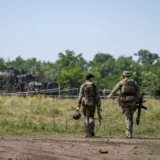Ukraine’s Counteroffensive Struggling Amidst Challenges
Ukraine is facing an uphill battle in its counteroffensive against Russia. The once optimistic narrative of imminent victory has given way to a more somber acknowledgment that holding territory and minimizing casualties may be the more pragmatic goal.
Colonel Roman Kostenko, a seasoned commander on the Kherson front and a member of Ukraine’s parliament, expressed doubt about the effectiveness of promised U.S. and allied weaponry. In his candid assessment, he highlighted the limitations of weapons like long-range ATACMS missiles and F-16 fighters against Russia’s vast military capabilities. The disparity in resources, he argued, puts Ukraine in a precarious position.
While President Zelensky has called for a mobilization of half a million men to replace battlefield losses, the Ukrainian Armed Forces face a shortage of personnel for critical tasks, such as operating German-made Leopard 2 tanks. The challenge is not only on the battlefield but extends to the ability to train and equip forces effectively.
Political disputes in Brussels and Washington have led to a drying up of military and financial aid from the West. Ukrainian Defense Minister Rustem Umerov expressed optimism that the U.S. would not abandon Ukraine, but the reality on the ground suggests a different picture. The blame game echoes within Kiev, with Zelensky’s adviser, Mikhail Podoliak, pointing fingers at the West for not providing timely support.
Compounding these issues is the rampant corruption within Ukraine. Despite the ongoing conflict, Podoliak revealed that corrupt practices persist among public officials, undermining the trust of the Ukrainian people. The internal struggles within Ukraine, both on the battlefield and in the corridors of power, paint a grim picture of a nation grappling with its own demons.
The New York Times and Washington Post have shed light on aggressive conscription tactics, desperation to find fresh conscripts, and a disillusioned population reluctant to fight for a government perceived as corrupt and incompetent. Reports of recruiters “snatching” men off the streets, forcing the injured and disabled into service, and individuals resorting to bribery and forgery to avoid conscription illustrate the multifaceted challenges facing Ukraine.
There is discord among frontline troops, questioning why they must sacrifice for a government they perceive as uncaring. The widening gap between the military and the government, coupled with the toll of significant casualties, raises concerns about the cohesion of Ukraine’s armed forces.
As the narrative shifts in Western media from optimism to skepticism, the reality on the ground demands a nuanced understanding of the challenges Ukraine faces. The once-clear path to victory now seems fraught with obstacles, and the Ukrainian people are caught in the crossfire between geopolitical forces and the shortcomings of their own government. In the face of these challenges, Ukraine’s leaders struggle to navigate a complex landscape while battling internal discord.





